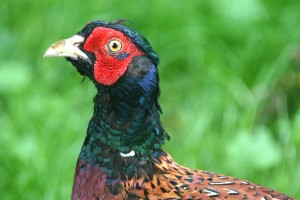 This is the time of the year when there seems to be pheasants everywhere whether on the roads, in woodland or in the open fields. There is a good reason for this as a few weeks ago many thousands, tens of thousands would not be an exaggeration, have been released in Scotland. These are for shooting, although in the Highlands it is more or less confined in such large numbers mainly to the south east going up the east coast and even as far as north east Caithness. This is now a multi-million pound “business” and the amounts paid for such shooting can be very large indeed. Some of this involves quite small shoots with say around 200 pheasants released and no full time keepers. In contrast, full time keepers may be employed and very many birds “put down”, sometimes running into thousands on the larger estates. There are no figures for the number of bird released in Scotland but in the UK as a whole one estimate suggests 25 million pheasants each year! These introductions may not only involve pheasants but also duck, mainly mallard, but also red-legged partridge and grey partridge.
This is the time of the year when there seems to be pheasants everywhere whether on the roads, in woodland or in the open fields. There is a good reason for this as a few weeks ago many thousands, tens of thousands would not be an exaggeration, have been released in Scotland. These are for shooting, although in the Highlands it is more or less confined in such large numbers mainly to the south east going up the east coast and even as far as north east Caithness. This is now a multi-million pound “business” and the amounts paid for such shooting can be very large indeed. Some of this involves quite small shoots with say around 200 pheasants released and no full time keepers. In contrast, full time keepers may be employed and very many birds “put down”, sometimes running into thousands on the larger estates. There are no figures for the number of bird released in Scotland but in the UK as a whole one estimate suggests 25 million pheasants each year! These introductions may not only involve pheasants but also duck, mainly mallard, but also red-legged partridge and grey partridge.
In many ways such pheasant rearing, releasing and shooting can be compatible and even beneficial to wildlife conservation. For example, woodland managed for pheasants can be equally attractive to many other birds from woodcock to many small birds. The actual putting down of large amounts of food for the pheasants such as mixed grain can also feed many other birds from yellowhammers to blackbirds and chaffinches to greenfinches. For estates that introduce mallard then a pond is useful. This attracts the mallard for shooting but it can go much further than this, depending on the design. If the pond has shallow margins and an undulating outline plus at least three feet of water in the middle then it will be good for duck. It will also be ideal for a wide variety of other wildlife from amphibians to dragonflies and birds to fish. Ideally for both for duck and the other wildlife the depth of water need to be constant so a permanent supply of water plus dams and sluices are important.
For those people feeding birds in the garden they can expect to attract pheasants and such is the case with most gardens around Inverness. At the moment, for example, at any one time there are up to ten pheasants at my feeders and the overall figure must be far in excess of that. Some people like them whilst others take the opposite view but you cannot but help admire the plumage of a cock pheasant at this time of the year. I took the photograph last week in the garden where it was a feeding on mixed grain put down for “wild” birds. It is sometimes difficult to remember that this is not a native bird as it was introduced into England by the Romans whilst the introduction to Scotland did not take place until the 16th Century.
This is the time of the year that with the maximum number of pheasants around there are bound to be many road casualties. The pheasant is often the commonest road casualty and it is worth remembering that they are only the ones we actually see. There are many predators from fox to buzzard and badger to stoat that will take these easy pickings before we ever seen them on a morning. Despite all the controversy over shooting pheasants it looks as though this aspect of country life is here to stay.
Tags: highland wildlife
